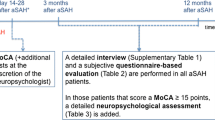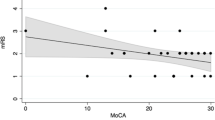Abstract
Subarachnoid hemorrhage (SAH) is known to be associated with long-term cognitive deficits. Neurosurgical manipulation on the brain itself has been reported to have influence on neuropsychological sequelae. The following is a comparative study on perimesencephalic and aneurysmal subarachnoid hemorrhage patients as well as elective aneurysm patients that was carried out to determine the isolated and combined impact of surgical manipulation and hemorrhage, respectively, on long-term neuropsychological outcome. Inclusion criteria were good neurological recovery at discharge (modified Rankin Scale 0 or 1) without focal neurological deficit. Standardized psychological testing covered attention, memory, executive functions, and mood. Thirteen aneurysmal SAH patients, 15 patients undergoing elective clipping, and 14 patients with perimesencephalic SAH were analyzed. Standardized neuropsychological testing and social/professional history questionnaires were performed 2 years (mean) after discharge. Memory impairment and slower cognitive processing were found in the aneurysmal and perimesencephalic SAH groups, while elective aneurysm patients showed signs of impaired attention. However, compared with norm data for age-matched healthy controls, all groups showed no significant test results. In contrast, signs of clinical depression were seen in 9/42 patients, 45 % of all patients complained of stress disorders and 55 % of patients were unable to work in their previous professions. Nearly normal neuropsychological test results on long-term follow-up in SAH patients were unexpected. However, a 50 % rate of unemployment accompanied with stress disorders and depression manifests insufficient social and workplace reintegration. Therefore, even more specific rehabilitation programs are required following inpatient treatment to attain full recovery.
Similar content being viewed by others
References
Ahola K, Vikki J, Servo A (1996) Frontal tests do not detect frontal infarctions after ruptured intracranial aneurysm. Brain Cogn 31(1):1–16
Bellebaum C, Schafers L, Schoch B, Wanke I, Stolke D, Forsting M, Daum I (2004) Clipping versus coiling: neuropsychological follow up after aneurysmal subarachnoid haemorrhage (SAH). J Clin Exp Neuropsychol 26(8):1081–1092
Beristain X, Gaviria M, Dujony M, TH A e-B, Stark JL, Ausman JI (1996) Evaluation of outcome after intracranial aneurysm surgery: the neuropsychiatric approach. Surg Neurol 45:422–429
Buchanan KM, Elias IJ, Goplen GB (2000) Differing perspectives on outcome after subarachnoid hemorrhage: the patient, the relative, the neurosurgeon. Neurosurgery 46:831–838
Chan A, Ho S, Poon WS (2002) Neuropsychological sequelae of patients treated with microsurgical clipping or endovascular embolization for anterior communicating artery aneurysm. Eur Neurol 47(1):37–44
Desantis A, Laiacona M, Barbarotto R, Basso A, Villani R, Spagnoli D, Capitani E (1998) Neuropsychological outcome of patients operated upon for an intracranial aneurysm:analysis of general prognostic factors and the effects of the location of the aneurysm. Neurology Neurosurgery Psychiatry 52:1135–1140
Dombovy ML, Drew-Cates J, Serdans R (1998) Recovery and rehabilitation following subarachnoid hemorrhage. Part II. Long term follow-up. Brain Inj 12:887–894
Fobe JL, Haddad L, De Souza AM (1999) Cognitive performance in patients with surgically treated cerebral aneurysms. Arq Neuropsiquiatr 57(2A):233–242
Fontanella M, Perozzo P, Ursone R, Garbossa D, Bergui M (2003) Neuropsychological assessment after microsurgical clipping or endovascular treatment for anterior communicating artery aneurysm. Acta Neurochir (Wien) 145:867–872
Freckmann N, Stegen G, Valdueza JM (1994) Long-term follow-up and quality of life after aneurysmal subarachnoid hemorrhage. Aktuelle Neurol 21:84–88
Germano A, Tisano A, Raffaele M, Munaò F, Cacciola F, La Rosa G, Tomasello F (1997) Is there a group of early surgery aneurysmal SAH patients who can expect to achieve a complete long-term neuropsychological recovery? Acta Neurochir 139(6):507–514
Hadjivassiliou M, Tooth CL, Romanowski CA, Byrne J, Battersby RD, Oxbury S, Crewswell CS, Burkitt E, Stokes NA, Paul C, Mayes AR, Sagar HJ (2001) Aneurysmal SAH: cognitive outcome and structural damage after clipping or coiling. Neurology 56(12):1672–1677
Härting C, Markowitsch HJ, Neufeld H (2000) u. a. Wechsler Gedächtnis Test - Revidierte Fassung (WMS-R): Deutsche Adaptation der revidierten Fassung der Wechsler-Memory-Scale. Hogrefe-Verlag GmbH & Co. KG, Göttingen
Hautzinger M, Bailer M (1993) Allgemeine Depressionsskala (ADS). Hogrefe-Verlag GmbH & Co. KG, Göttingen
Helmstaedter C, Lendt M, Lux S (2000) Verbaler Lern- und Merkfähigkeitstest. Hogrefe-Verlag GmbH & Co. KG, Göttingen
Hillis AE, Anderson N, Sampath P, Rigamonti D (2000) Cognitive impairments after surgical repair of ruptured and unruptured aneurysms. J Neurol Neurosurg Psychiatry 69:608–615
Horn W (2000) Leistungsprüfsystem (LPS). 2. Aufl. Hogrefe-Verlag GmbH & Co. KG, Göttingen
Hütter BO, Kreitschmann-Andermahr I, Gilsbach JM (1998) Cognitive deficits in the acute stage after subarachnoid hemorrhage. Neurosurgery 43(5):1054–1065
Hütter BO, Kreitschmann-Andermahr I, Gilsbach JM (2001) Health related quality of life after aneurysmal subarachnoidal hemorrhage: impacts of bleeding severity, computerized tomography findings, surgery, vasospasm and neurological grade. J Neurosurg 94(2):241–251
Kreiter KT, Copeland D, Bemardini GL, Bates JE, Peery S, Claassen J, Du YE, Stern Y, Connolly ES, Mayer SA (2002) Predictors of cognitive dysfunction after subarachnoid hemorrhage. Stroke 33(1):200–208
Jankowicz E, Halicka D, Drozdowski W (2002) Neuropsychological deficits after surgical repair of anterior communicating artery aneurysm. Neurol Neurochir Pol 36(2):315–327
Larsson C, Forssell A, Ronnberg J, Lindberg M, Nilsson LG, Fodstad H (1994) Subarachnoid blood on CT and memory dysfunctions in aneurysmal subarachnoid hemorrhage. Acta Neurol Scand 90(5):331–336
Madureira S, Canhão P, Guerreiro M, Ferro JM (2000) Cognitive and emotional consequences of perimesencephalic subarachnoid hemorrhage. J Neurol 247(11):862–867
Ohue S, Oka Y, Kumon Y, Ohta S, Sakaki S, Hatakeyama T, Shiraishi T, Takeda S, Ohnishi T (2003) Importance of neuropsychological evaluation after surgery in patients with unruptured cerebral aneurysms. Surg Neurol 59(4):269–275
Otawara Y, Ogasawara K, Ogawa A, Yamadate K (2005) Cognitive function before and after surgery in patients with unruptured intracranial aneurysm. Stroke 36(1):142–143
Perea-Bartolome MV, Ladera-Fernandez V, Morales-Ramos F, Pastor-Zapata A (2004) Mnemonic performance in patients following surgery to treat an aneurysm affecting the anterior circulation of the brain. Rev Neurol 39(1):7–12
Powell J, Kitchen N, Heslin J, Greenwood R (2002) Psychosocial outcomes at three and nine months after good neurological recovery from aneurysmal subarachnoid hemorrhage: predictors and prognosis. J Neurol Neurosurg Psychiatry 72:772–781
Reitan RM (2000) Trail Making Test (TMT). Hogrefe-Verlag GmbH & Co. KG, Göttingen
Reppermund S, Ising M, Lucae S, Zihl J (2009) Cognitive impairment in unipolar depression is persistent and non-specific: further evidence for the final common pathway disorder hypothesis. Psychol Med 39(4):603–614
Sheldon S, Macdonald RL, Schweizer TA (2012) Free recall memory performance after aneurysmal subarachnoid hemorrhage. J Int Neuropsychol Soc 18(2):334–342
Simard S, Rouleau I, Brosseau J, Laframboise M, Bojanowsky M (2003) Impact of executive dysfunctions on episodic memory abilities in patients with ruptured aneurysm of the anterior communicating artery. Brain Cogn 53(2):354–358
Tidswell P, Dias PS, Sagar HJ, Mayes AR, Battersby RD (1995) Cognitive outcome after aneurysm rupture: relationship to aneurysm site and perioperative complications. Neurology 45(5):875–882
Towgood K, Ogden JA, Mee E (2004) Neurological, neuropsychological, and psychosocial outcome following treatment of unruptured intracranial aneurysms: a review and commentary. J Int Neuropsychol Soc 10(1):114–134
Tuffiash E, Tamargo RJ, Hillis AE (2003) Craniotomy for treatment of unruptured aneurysms is not associated with long-term cognitive dysfunction. Stroke 34(9):2195–2199
van Gijn J, Rinkel GJ (2001) Subarachnoid haemorrhage: diagnosis, causes and management. Brain 124(Pt 2):249–278
Wong GKC, Ngai K, Wong A, Lam S, Mok V, Yeung J, Rainer T, Wong R, Poon W (2012) Long-term cognitive dysfunction in patients with traumatic subarachnoid hemorrhage: prevalence and risk factors. Acta Neurochir (Wien) 154(1):105–111
Zimmermann P, Fimm B (2002) Testbatterie zur Aufmerksamkeitsprüfung (TAP), Version 1.7. Psytest
Acknowledgments
We would like to thank the psychological department of the University of Hamburg for technical support and C. Wein and P. Pawlik personally for their advice in choosing psychological tests.
Conflict of interest
The authors have no conflicts of interest or financial affiliations to disclose.
Author information
Authors and Affiliations
Corresponding author
Additional information
Comments
Takashi Sadatomo, Hiroshima, Japan
The author clarified in this article that 55 % of the patients who underwent aneurismal clipping or suffered from perimesencephalic SAH lost their previous work, and the unemployment rates among each group (A, B, and C) did not show differences (A = 7/13, B = 8/15, C = 8/14). And, these patients did not show focal neurological deficits and significant cognitive deficits. So the author mentions that diagnostic awareness for minor cognitive complaints and depressive episode must be heightened and professional help must took effect and then informing the patients these possible problems is necessary.
These results from this article seem to contain important information although the number of the patients is small for now. As a next step, it would be hopeful that the author will also disclose which lines of profession are difficult or relatively easy to regain for the patients.
These information would be imperative especially for the cases of unruptured aneurysms when they were confirmed in a large scale.
Rights and permissions
About this article
Cite this article
Krajewski, K., Dombek, S., Martens, T. et al. Neuropsychological assessments in patients with aneurysmal subarachnoid hemorrhage, perimesencephalic SAH, and incidental aneurysms. Neurosurg Rev 37, 55–62 (2014). https://doi.org/10.1007/s10143-013-0489-3
Received:
Revised:
Accepted:
Published:
Issue Date:
DOI: https://doi.org/10.1007/s10143-013-0489-3




